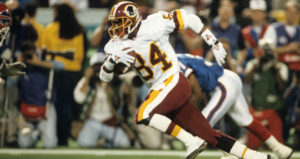Judging wide receivers is very tough. One way to do that is to look just at their raw statistics, but a receiver’s production is heavily influenced by the environment he plays in — how often does his team pass, how talented is his quarterback, how good are the other targets on his team, etc. At a high level, it’s easy to assume that the best receivers are playing on the best passing attacks: after all, if a passing game is dominant, the receivers are likely a big part of the reason why.
The 1984 Dolphins, 2004 Colts, 2007 Patriots, and 2013 Broncos all had record-setting passing attacks. And while Dan Marino, Peyton Manning, and Tom Brady were great, but they also each had not one, but two star receivers: Mark Clayton and Mark Duper, Reggie Wayne and Marvin Harrison (and Brandon Stokley), Randy Moss and Wes Welker and Demaryius Thomas and Eric Decker (and Wes Welker!). That’s generally the rule, not the exception: dynamic offenses almost always have a great quarterback, but they also almost always have multiple top receivers. The Falcons offense was outstanding last year, and it’s hard for a wide receiver to be better than Julio Jones, but even he only accounted for 28% of the Atlanta receiving yards and 16% of the Falcons receiving touchdowns (Jones also missed two games).
The receivers who play on the teams with the biggest pies can make the case that they were a driving force for a mammoth level of production. But getting a large share of the pie is really impressive, too. After all, if a receiver’s quarterback is terrible, all you can ask a wide receiver to do is be responsible for as much of the limited production that his team has as possible. Consider Isaac Bruce — a player we know was an outstanding receiver — and the 1996 Rams.
The main quarterback was rookie Tony Banks, who wasn’t very good even in his prime and was worse as a rookie. The Rams ranked 29th in ANY/A and 28th in passing yards in a 30-team NFL. But Bruce still gained 1,338 yards and scored 7 touchdowns — making him responsible for about 40% of the team’s producing in the passing game. The same goes for Anquan Boldin on the 2003 Cardinals: playing with 33-year-old Jeff Blake and 24-year-old Josh McCown, Arizona had one of the worst passing attacks in the NFL. And while the raw numbers for Boldin were still strong, what was really remarkable is that he accounted for over 40% of his team’s receiving production.
So a great wide receiver on a bad offense can still stand out by gobbling up targets. And a great wide receiver surrounding by a strong offense can help that offense reach great heights. But what about doing both?
Jerry Rice did that for a host of 49ers teams, which is one of the reasons he was the greatest receiver in NFL history. But that’s what Clark did on the ’91 Skins, too.
Lest you forget, Washington was by far the best passing offense in the NFL that season. The Redskins averaged 8.3 ANY/A that year; by way of comparison, only five teams that year averaged even 6.0 ANY/A. Mark Rypien produced dominant numbers that year, but he didn’t do it by spreading the ball around: he did it by force-feeding Clark and to a lesser extent, Art Monk. Clark saw 36% of all Redskins receiving yards and a third of the Washington passing touchdowns. In the last 30 years, the only wide receivers to gain 30% of their team’s production on a passing offense that was at least 3.00 ANY/A above average are Moss in ’07, Rice in ’92, Clark in ’91, and Rice in ’89.
Clark’s raw numbers don’t stand out as insane today — 70 catches for 1,340 yards and 10 touchdowns — but that’s pretty misleading.
- Washington ranked 26th in the 28-team NFL in pass attempts, because Washington played with the lead all the time that year. There just wasn’t much opportunity for Clark to produce big numbers.
- Clark wasn’t just eating up targets on a bad team — he was competing with Art Monk and Ricky Sanders for targets! This was not a Rob Moore 1997 situation.
- Unlike Moss or Rice or Harrison, Clark wasn’t playing with a Hall of Fame quarterback.
In three playoff games, Clark caught 17 passes for 255 yards and 2 more touchdowns. Which may not sound like alike, but again, it was 37% of the Redskins receiving yards and 50% of the team’s receiving touchdowns during the playoffs.
It’s impressive to have a great seasons statistically. It’s impressive to play for an elite passing offense. It’s impressive to be a hog when it comes to splitting up your team’s receiving pie. Gary Clark managed is one of only a handful to have done all three in the same year, and he finished that year by earning his second Super Bowl ring. That’s a season worth remembering.

